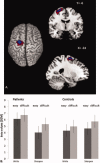Writer's cramp: increased dorsal premotor activity during intended writing
- PMID: 22113948
- PMCID: PMC6870150
- DOI: 10.1002/hbm.21464
Writer's cramp: increased dorsal premotor activity during intended writing
Abstract
Simple writer's cramp (WC) is a task-specific form of dystonia, characterized by abnormal movements and postures of the hand during writing. It is extremely task-specific, since dystonic symptoms can occur when a patient uses a pencil for writing, but not when it is used for sharpening. Maladaptive plasticity, loss of inhibition, and abnormal sensory processing are important pathophysiological elements of WC. However, it remains unclear how those elements can account for its task-specificity. We used fMRI to isolate cerebral alterations associated with the task-specificity of simple WC. Subjects (13 simple WC patients, 20 matched controls) imagined grasping a pencil to either write with it or sharpen it. On each trial, we manipulated the pencil's position and the number of imagined movements, while monitoring variations in motor output with electromyography. We show that simple WC is characterized by abnormally increased activity in the dorsal premotor cortex (PMd) when imagined actions are specifically related to writing. This cerebral effect was independent from the known deficits in dystonia in generating focal motor output and in processing somatosensory feedback. This abnormal activity of the PMd suggests that the task-specific element of simple WC is primarily due to alterations at the planning level, in the computations that transform a desired action outcome into the motor commands leading to that action. These findings open the way for testing the therapeutic value of interventions that take into account the computational substrate of task-specificity in simple WC, e.g. modulations of PMd activity during the planning phase of writing.
Copyright © 2011 Wiley Periodicals, Inc.
Figures



References
-
- Bakker M, de Lange FP, Helmich RC, Scheeringa R, Bloem BR, Toni I ( 2008): Cerebral correlates of motor imagery of normal and precision gait. Neuroimage 41: 998–1010. - PubMed
-
- Berardelli A, Rothwell JC, Hallett M, Thompson PD, Manfredi M, Marsden CD ( 1998): The pathophysiology of primary dystonia. Brain 121 (Pt 7): 1195–1212. - PubMed
-
- Braun C, Schweizer R, Heinz U, Wiech K, Birbaumer N, Topka H ( 2003): Task‐specific plasticity of somatosensory cortex in patients with writer's cramp. Neuroimage 20: 1329–1338. - PubMed
MeSH terms
Substances
LinkOut - more resources
Full Text Sources

